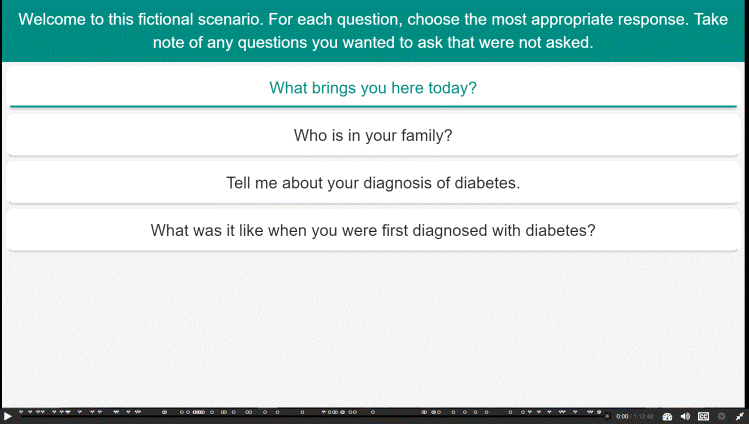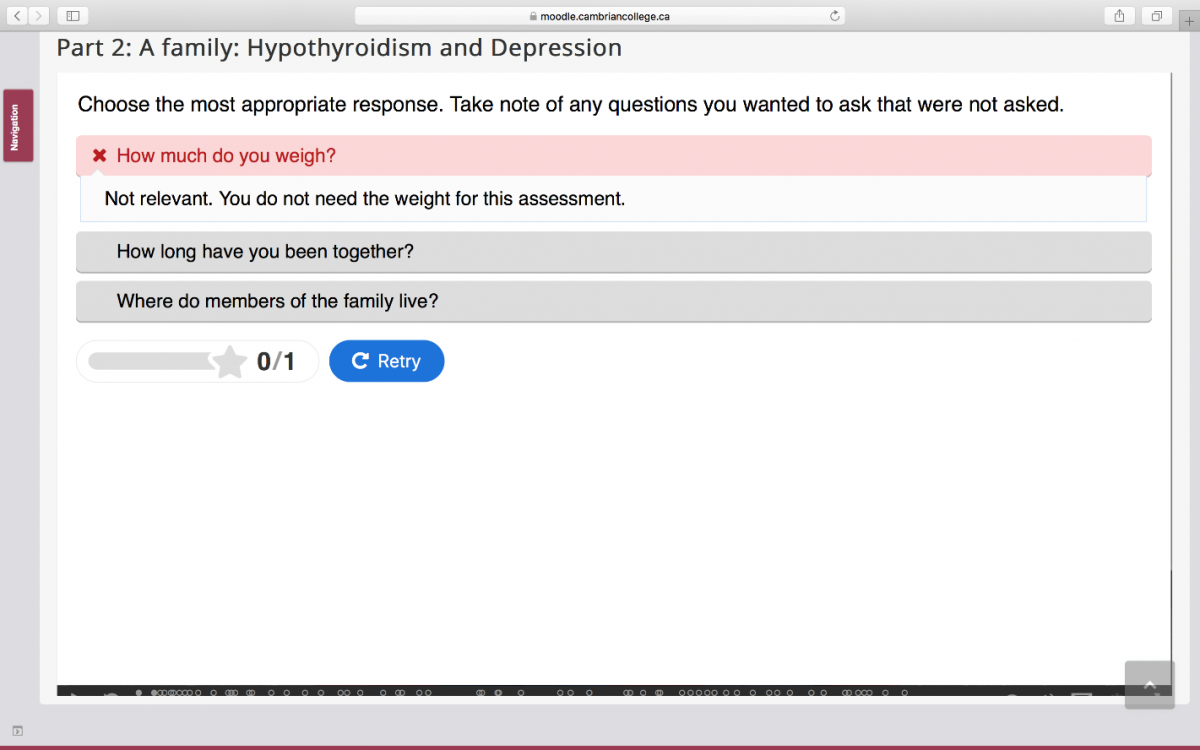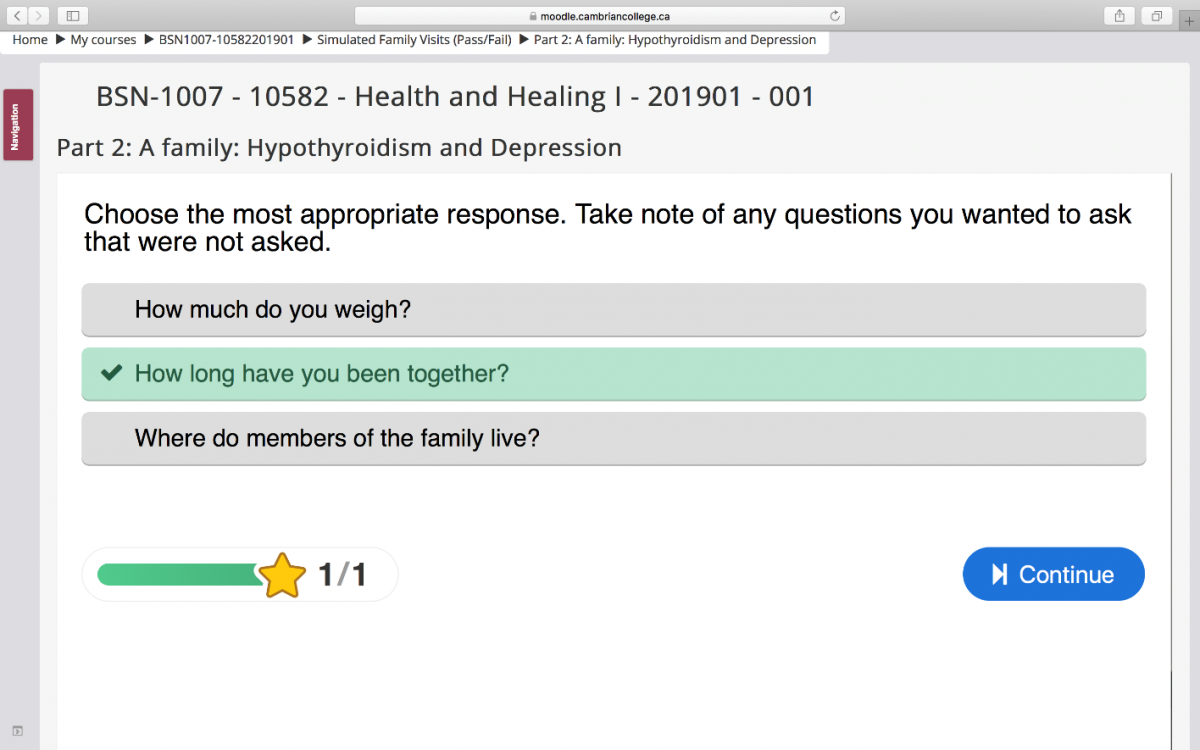Opportunity
In the first year of Cambrian College’s Bachelor of Science in Nursing degree program (in collaboration with Laurentian University), students are required to take the core course BSN 1007 Health and Healing I - Family Experience of a Chronic Health Challenge.
In this course, students focus on developing an understanding of family experiences with chronic health challenges and participate in a health assessment of individuals and families following a recognized framework to explore the meanings of health for individuals and their family members.
Student challenges are multidimensional; however, consistent challenges relate to the problematic nature of the in-home family visits where students work in pairs to interview/visit a family member living with a chronic health challenge.
The challenges included:
- Partner problems;
- Difficulties with finding a suitable family to visit;
- Challenges in arranging family visits;
- Families backing out at the last minute;
- Lack of consistency with the experiences;
- Issues of coordinating schedules of students and faculty advisers;
- Lacking the skills required to assess the family;
- High stakes assessment - 40% of the final grade.>
Based on these challenges, Professor Laura Killam reexamined the learning outcomes of the family visits and with input from former and current students, colleagues, and her Dean, she looked for opportunities to create a more valuable learning experience for her students. After an unsuccessful search for existing simulations to meet the needs of the students, Professor Killam decided to create her own. She turned to Cambrian College’s Teaching and Learning Innovation Hub to help implement her idea of using simulations.
Innovation
Inspired by the conversations and presentations at ONLINE LEARNING 2018: Global Online Learning Summit, Professor Killam developed the scenarios for the family visit simulations, recruited the actors and used the resources of the dedicated video room in the Teaching and Learning Innovation Hub.
With the help of cameraman and multimedia specialist Jeffery Tranchemontagne, Professor Killam created 3 video scenarios: 2 based on fictitious characters and 1 based on a real case study with a volunteer living with a chronic illness, who shared their story. To accommodate for accessibility, Professor Killam added closed captions of the dialogue at the bottom of the screen.

Screen shot of scenario video. Interactions are shown along the bottom of the timeline.
After the videos were created and edited, Professor Killam worked closely with Sarah Wendorf, Instructional Designer, to problem-solve what technology would best suit her needs for the interaction aspect. They decided to use the application H5P, a free and open-source content collaboration framework that allows users to create, share and reuse interactive HTML5 content. With this application, Professor Killam added the element of interaction with the video content, where students are guided through parts one and two of simulated visits. At the points indicated on the timeline, multiple-choice questions pop up on the screen probing the students’ knowledge of the content and what questions to ask next based on either branching logic or linear logic.
Part One: Branching Logic
Part one of the simulations uses branching logic, which creates a custom path based on the student’s responses. Branching logic is used for the assessment of a family’s chronic health challenge as there are a variety of paths students could logically take to ask relevant questions.

Opening question in one of the simulations.

Automated feedback indicates the best response was selected and why it was the best response.

Automated feedback indicates the student did not select the correct response and why.
Part Two: Linear Logic
Part two uses linear logic, where the assessment framework works in a straightforward pathway. Here students can retry questions until they answer correctly.
In both parts of the simulation, students are not permitted to skip forward or backwards in the timeline. Each option the student chooses provides them with feedback on their choice.

In Part Two of the simulations, students can retry if they get the answer wrong.

After the correct response, the video continues to play.
Benefits/Outcomes
The family visit simulations piloted in February 2019, with approximately 70 students. The student response was very positive, with students benefiting from the flexibility and autonomy of the simulations, including the option to repeat as often as needed. It also allowed them to review the assessment frameworks and figure out the best path through the assessment.
Not only was this beneficial to the students, it helped the faculty and administration by preventing the issues of finding a suitable family, scheduling visits and dealing with partners. It also resulted in less complaints from students.
Once created, the H5P objects require no ongoing maintenance, creating a cost-effective and sustainable means of upkeep.
Challenges and Enhancements
For students, the content in the fictitious scenarios met the learning outcomes in the course in a more succinct way. The real scenario was a rich learning experience and therefore had more data and information that was required for the students to process. To address this issue, Professor Killam is looking to use the real scenario as an in-class example to model with the students and have three fictitious scenarios with consistent amounts of detail for the simulations.
Other observations from students include the length of time it takes to complete the simulation, and the feedback lag time from the instructor when students were working from home, which made immediate responses to student concerns more challenging (e.g. they couldn’t get an immediate response if they ran into an issue).
Based on this feedback, Professor Killam has ideas on how to improve upon the simulations for the following year, including;
- Keeping the simulations to a manageable length;
- In class pre-brief and post brief;
- Dedicated class time in a computer lab for students to begin the simulations;
- Using the new branching technology in H5P for all simulations;
- Quizzing students on the content extracted from the scenarios to make sure they understood key concepts before they complete the associated essay;
- Re-try button; and
- Tracking students as they progress through the simulations.
Potential
As simulation development in H5P progresses, Professor Killam sees potential for the use of simulation and H5P, particularly in nursing clinical courses, where students can use simulation to help prepare for labs. Potential also exists beyond the nursing program, where H5P technology can be used in a variety of applications to enhance simulation in any hands-on programs such as police, paramedic and firefighting.
For Further Information
Laura Killam
Professor and Innovation Champion
Cambrian College of Applied Arts and Technology
Sudbury, Ontario
[email protected]


